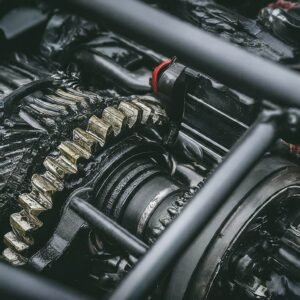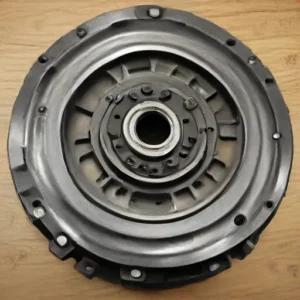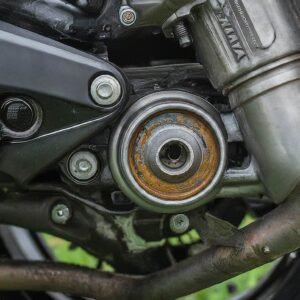The most common Yamaha RMAX 1000 problems are starting, transmission, engine overheating, engine misfire, clutch issues, brake problems, rear axle click, and poor gas mileage.
Here, we explore these problems in detail with their easy solutions.
Yamaha RMAX 1000 problems and solutions
Now, we will explore the most common problems of the Yamaha RMAX 1000 with their easy solutions. Also explore the Yamaha Wolverine X2 Problems.
1. Starting Problems

As a Yamaha RMAX 1000 owner, you might occasionally face starting problems. These issues can be frustrating, but understanding their root causes can help you address them effectively. Common starting problems include battery issues, faulty spark plugs, and fuel system malfunctions.
Battery-Related Issues
A dead or weak battery is one of the most common reasons your Yamaha RMAX 1000 won’t start. Ensure the battery is fully charged and the terminals are clean and secure.
A multimeter can help you check the battery’s voltage; ideally, it should be around 12.6 volts or higher when fully charged. If the battery is old or damaged, consider replacing it.
Inspecting Spark Plugs
Faulty or dirty spark plugs can also prevent your RMAX 1000 from starting. Remove the spark plugs and inspect them for signs of wear or carbon buildup. Clean or replace them if necessary.
It’s good practice to check the spark plug gap and ensure it matches the manufacturer’s specifications, which are in the owner’s manual.
Fuel System Troubleshooting
The fuel system is another critical area to examine. Ensure there’s enough fuel in the tank and fresh fuel. Over time, gasoline can become stale, leading to starting problems.
Check the fuel filter for clogs and the fuel pump for proper operation. If the fuel filter is dirty, replace it, and if the fuel pump is malfunctioning, it might need professional repair or replacement.
2. Yamaha RMAX 1000 Transmission Problems

One of the most frequently reported issues with the Yamaha Rmax 1000 transmission is difficulty shifting gears. Users often experience a ‘hard shift,’ where changing gears requires more effort than usual.
Another common problem is a delay in gear engagement, which can be particularly troubling when you need an immediate power response.
Another prevalent issue is transmission overheating. Overheating can cause significant damage to the transmission components, leading to costly repairs.
This problem is often exacerbated during prolonged use in rugged terrain or hot weather conditions.
Solutions
Regular maintenance is critical to addressing hard shifting. Ensure the transmission fluid is at the correct level and changed according to the manufacturer’s guidelines.
Using the recommended type of transmission fluid is crucial for the smooth operation of the gearbox.
It is advisable to check the condition of the transmission belts for delays in gear engagement. Worn or damaged belts can cause significant delays. Replacing them periodically can help maintain optimal performance.
If overheating is a concern, installing an aftermarket transmission cooler can be an effective solution. This can help dissipate heat more efficiently, preventing the transmission from reaching critical temperatures. Additionally, taking breaks during extended use can help manage heat buildup.
3. Engine Overheating
Engine overheating in the Yamaha RMAX 1000 can be attributed to several factors:
- Clogged Radiator: Dirt, mud, and debris can clog the radiator, restricting airflow and causing the engine to overheat.
- Low Coolant Levels: Insufficient coolant can impair the cooling system’s effectiveness, leading to overheating.
- Faulty Thermostat: A malfunctioning thermostat can disrupt the coolant flow, resulting in higher engine temperatures.
- Water Pump Issues: A damaged or failing water pump can prevent the coolant from circulating properly, causing the engine to overheat.
Solutions
Here are some steps you can take to prevent and resolve engine overheating in your Yamaha RMAX 1000:
- Regular Maintenance: Clean the radiator regularly to remove any obstructions. Ensure the radiator fins are straight and intact.
- Check Coolant Levels: Regularly check and top up coolant levels as needed. Use the recommended coolant type for your vehicle.
- Thermostat Inspection: Test the thermostat periodically to ensure it opens and closes properly. Replace it if it’s faulty.
- Water Pump Check: Inspect the water pump for signs of wear or damage. Replace it if necessary to maintain proper coolant circulation.
4. Engine Misfire
Engine misfire in the Yamaha RMAX 1000 can be attributed to several factors. Common causes include:
- Faulty Spark Plugs: Worn or damaged spark plugs can lead to incomplete combustion, causing the engine to misfire.
- Fuel Injector Issues: A clogged or malfunctioning fuel injector can disrupt the fuel-air mixture, resulting in a misfire.
- Ignition Coil Problems: A failing ignition coil can prevent the spark plugs from firing correctly, leading to misfires.
- Vacuum Leaks: Leaks in the vacuum system can alter the air-fuel ratio, causing the engine to misfire.
Also explore the Kawasaki KFX 700 problems
Symptoms of Engine Misfire
Recognizing the symptoms of an engine misfire can help you address the issue promptly. Common symptoms include:
- Rough Idling: If the engine feels rough or shaky while idling, it could signify a misfire.
- Loss of Power: A noticeable drop in power or acceleration may indicate that the engine is misfiring.
- Check Engine Light: The check engine light may illuminate if the onboard diagnostics system detects a misfire.
- Unusual Exhaust Emissions: Excessive smoke or unusual odors from the exhaust can be a symptom of incomplete combustion.
Solutions to Engine Misfire
Once you identify the cause of the misfire, you can take appropriate steps to resolve it:
- Replace Spark Plugs: Ensure the spark plugs are in good condition and replace them if necessary.
- Clean or Replace Fuel Injectors: Regular maintenance of fuel injectors can prevent clogging and ensure proper fuel delivery.
- Inspect Ignition Coils: Check the ignition coils for any signs of wear or damage and replace them if needed.
- Check for Vacuum Leaks: Inspect the vacuum system for leaks and repair damaged components.
5. Yamaha RMAX 1000 Clutch Problems

One of the most frequent issues reported by users is clutch slippage. This happens when the clutch does not fully engage, causing a loss of power and inefficient performance.
Another common problem is clutch overheating, resulting from excessive use or improper maintenance.
Lastly, clutch noise is often reported, indicating worn-out components or misalignment within the clutch system. Also explore the best offroad vehicles.
Solutions
To address clutch slippage, it’s essential to check the clutch plates and springs for wear and tear. Replacing these components often resolves the issue.
For clutch overheating, ensure that the clutch is lubricated correctly and consider upgrading to a higher-quality oil that can withstand higher temperatures. Regular maintenance, such as cleaning and adjusting the clutch, can prevent overheating.
If you hear unusual noises coming from the clutch, it’s advisable to inspect the clutch basket and bearings for any signs of damage. Replacing worn-out parts can significantly reduce noise and improve clutch performance.
6. Brake Problems

One of the most frequently reported issues with the Yamaha RMAX 1000 is brake fade. This occurs when the brakes lose effectiveness after prolonged use, especially in demanding conditions.
Another common problem is squeaky brakes, which can be annoying and indicate underlying issues. Additionally, some users have reported experiencing soft brake pedals, which can reduce braking performance and safety.
Solutions
Addressing brake fade involves checking the brake fluid levels and ensuring they are topped up with the manufacturer-recommended fluid. Inspecting the brake pads regularly and replacing them when they show signs of wear is also crucial.
Cleaning the brake components and applying anti-squeal lubricant for squeaky brakes can often resolve the issue. If you encounter a soft brake pedal, it’s essential to bleed the brake lines to remove any air bubbles that might compromise the brake system’s integrity. Also explore the Kawasaki Brute Force 750 Problems.
7. Rear Axle Click

One primary reason for the clicking noise in the Yamaha RMAX 1000’s rear axle is wear and tear on the CV joints. Constant Velocity (CV) joints are crucial for transferring power from the transmission to the wheels while allowing movement in different directions.
Over time, these joints can become worn out, leading to a clicking sound. Another potential cause could be loose or damaged axle nuts. If the nuts are not properly tightened, they can cause the axle to move slightly, resulting in a clicking noise.
Solutions
If you’re experiencing a rear axle click, the first step is to inspect the CV joints. Look for any signs of wear or damage and replace them if necessary. You can find high-quality replacement parts from Yamaha or other reputable suppliers.
Additionally, ensure that the axle nuts are correctly tightened to the manufacturer’s specifications. If you’re uncomfortable doing this, consider taking your RMAX 1000 to a professional mechanic for a thorough inspection and repair.
8. Poor Gas Mileage
Several factors can contribute to poor gas mileage in the Yamaha RMAX 1000. One of the main culprits is driving habits. Aggressive driving, excessive idling, and rapid acceleration can significantly reduce fuel efficiency.
Also, improper tire pressure, dirty air filters, and outdated spark plugs can affect your vehicle’s performance.
Another factor to consider is the fuel quality. Lower-grade fuel can lead to incomplete combustion, resulting in higher fuel consumption. Using the recommended fuel type for optimal performance and efficiency is crucial. Also explore the Kawasaki Concours 1000 Problems.
Solutions to Improve Fuel Efficiency
Fortunately, there are several steps you can take to improve the gas mileage of your Yamaha RMAX 1000. Here are some practical solutions:
- Maintain Proper Tire Pressure: Regularly check and maintain the recommended tire pressure to reduce rolling resistance and improve fuel efficiency.
- Use High-Quality Fuel: Always use the recommended fuel type to ensure efficient combustion and performance.
- Regular Maintenance: Keep your RMAX 1000 in top condition by performing regular maintenance, including changing air filters and spark plugs as needed.
- Optimized Driving Habits: Adopt smoother driving habits by avoiding rapid acceleration and excessive idling. This can significantly enhance fuel efficiency.
Conclusion
As you can see, I have provided information about the Yamaha RMAX 1000 problems. So whenever you encounter any of these issues you can solve them easily.

